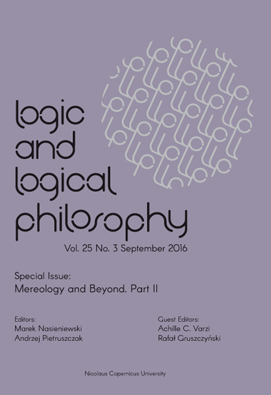“The whole is greater than the part.” Mereology in Euclid's Elements
DOI:
https://doi.org/10.12775/LLP.2016.011Słowa kluczowe
atomistic mereology, convex geometry, Euclidean plane, polygons, points, continuum, measure theoryAbstrakt
The present article provides a mereological analysis of Euclid’s planar geometry as presented in the first two books of his Elements. As a standard of comparison, a brief survey of the basic concepts of planar geometry formulated in a set-theoretic framework is given in Section 2. Section 3.2, then, develops the theories of incidence and order (of points on a line) using a blend of mereology and convex geometry. Section 3.3 explains Euclid’s “megethology”, i.e., his theory of magnitudes. In Euclid’s system of geometry, megethology takes over the role played by the theory of congruence in modern accounts of geometry. Mereology and megethology are connected by Euclid’s Axiom 5: “The whole is greater than the part.” Section 4 compares Euclid’s theory of polygonal area, based on his “Whole-Greater-Than-Part” principle, to the account provided by Hilbert in his Grundlagen der Geometrie. An hypothesis is set forth why modern treatments of geometry abandon Euclid’s Axiom 5. Finally, in Section 5, the adequacy of atomistic mereology as a framework for a formal reconstruction of Euclid’s system of geometry is discussed.Bibliografia
Aristotle, The Complete Works of Aristotle. The Revised Oxford Translation, J. Barnes (ed.) 2 vols., Princeton University Press, Princeton NJ, 1984.
Bélanger, Matthieu, and Jean-Pierre Marquis, “Menger and Nöbeling on pointless topology” Logic and Logical Philosophy, 22 (2013): 145–165. DOI: 10.12775/LLP.2013.009
Brentano, Franz, Philosophische Untersuchungen zu Raum, Zeit und Kontinuum, Meiner, Hamburg, 1976.
Carathéodory, Constantin, Mass und Integral und ihre Algebraisierung, Birkhäuser, Basel und Stuttgart, 1956.
Casati, Roberto, and Achille C. Varzi, Parts and Places, MIT Press, Boston MA, 1999.
Cohn, Anthony, “A more expressive formulation of many sorted logic”, Journal of Automated Reasoning, 3 (1987): 113–200. DOI: 10.1007/BF00243207
Hartshorne, Robin, Geometry: Euclid and Beyond, Springer, New York, 2000.
Heath, Thomas L., The Thirteen Books of the Elements, 3 vols, Dover Publications, Newburyport, 2012–2013. Reprint of the 2nd edition 1956. First edition: Cambridge University Press, Cambridge GB, 1908.
Hellman, Geoffrey, and Stewart Shapiro, “Regions-based two dimensional continua: the Euclidean case”, Logic and Logical Philosophy, 24 (2015): 499–534. DOI: 10.1305/ndjfl/1153858647
Hessenberg, Gerhard, and Justus Diller, Grundlagen der Geometrie, de Gruyter, Berlin and New York, 1967.
Hilbert, David, Grundlagen der Geometrie, Teubner, Leipzig, 1899, 14th edition, M. Toepell (ed.), Teubner 1999, Stuttgart. English translation by J. E. Townsend: Foundations of Geometry, Open Court
, LaSalle IL. 10th printing 1999. https://archive.org/details/thefoundationsof17384gut
Lewis, David, “Mathematics is megethology”, Philosophia Mathematica, 1, 1 (1993): 3–23. DOI: 10.1093/philmat/1.1.3
Mueller, Ian, Philosophy of Mathematics and Deductive Structure in Euclid’s Elements, MIT Press, Boston MA, 1981. Paperback edition: Dover, Newburyport, 2006.
Neuenschwander, Erwin, “Die ersten vier Bücher der Elemente Euklids”, Archive for the History of Exact Sciences, 9 (1973): 325–380. http://www.jstor.org/stable/41133382
Nöbeling, Georg, Grundlagen der analytischen Topologie, Springer, Berlin, 1954.
Pasch, Moritz, Vorlesungen über neuere Geoemtrie, Teubner, Leipzig, 1882. 2nd edition with an appendix by Max Dehn, Berlin: Springer 1926. Reprinted 1976.
Pratt, Ian, and Oliver Lemon, “Ontologies for plane, polygonal
mereotopology”, Notre Dame Journal of Formal Logic, 38, 2 (1997): 225–145. DOI: 10.1305/ndjfl/1039724888
Prenowitz, Walter, “A contemporary approach to classical geometry”, The American Mathematical Monthly, 68 (1961): 1–67. http://www.jstor.org/stable/2311902
Randell, David A., Zhan Cui, and Anthony G. Cohn, “A spatial logic based on regions and connections”, pages 165–176 in B. Nebel, Ch. Rich, and W. Swartout (eds.), Proceedings of the 3rd International Conference on Knowledge Representation and Reasoning, Los Altos CA, 1992. Morgan Kaufmann. http://wenxion.net/ac/randell92spatial.pdf
Roeper, Peter, “The Aristotelian continuum. A formal characterization”, Notre Dame Journal of Formal Logic, 47, 2 (2006): 211–232. DOI: 10.1305/ndjfl/1153858647
Schreiber, Peter, Theorie der geometrischen Konstruktion, Deutscher Verlag der Wissenschaften, Berlin, 1975.
Tarski, Alfred, “Appendix E”, pages 161–172 in J. Woodger, The Axiomatic Method in Biology, Cambridge UK: Cambridge University Press 1937.
Tarski, Alfred, “What is elementary geometry?”, pages 16–29 in L. Henkin, P. Suppes, and A. Tarski (eds.), The Axiomatic Method. With Special Reference to Geometry and Physics, North-Holland Publishing Company, Amsterdam, 1959. http://citeseerx.ist.psu.edu/viewdoc/download?doi=10.1.1.477.3340&rep=rep1&type=pdf
van der Vel, M.L.J., Theory of Convex Structures, North-Holland Publishing Company, Amsterdam, 1993.
Pobrania
Opublikowane
Jak cytować
Numer
Dział
Statystyki
Liczba wyświetleń i pobrań: 870
Liczba cytowań: 2







